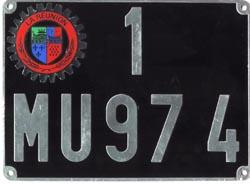The population of Reunion is approximately 800,000. The ethnic background of the Reunionese people include French, African, Malagasy, Chinese, Pakistani and Indian. French is the official language with Creole being widely used.

Oval : F
ISO : RE
Normal
series :
Series of up to two numerals and one serial letter from July
1950? : 1 A 974 to 99
Z 974
Series of up to two numerals and two serial letters from September
1951? : 1 AA 974 to 99
LZ 974
Series of up to three numerals (two or three numerals later) and
two serial letters (MA not issued) from July 1965 : 1
MB 974 to 999 ZZ 974
Series of two numerals and three serial letters from 17
October 1991 : 11 AAA 974 to 99
AZA 974
--> National file of license plates
numbers
Series of two or three numerals and three
serial
letters from 1 July 1993 : 11 AZB 974
to 999
AZZ
974
Series of two or three numerals
and three serial letters from 29 April 1994 to 13 October 2009 : 11
BAA 974 à 388 BZK 974 (last
number issued)
-->
SIV
Series of two serial letters,
three numerals and
two serial letters from 15 April 2009 : AA-003-AA
(first number issued
localy)
Nota
on the FNI period :
From 1993 to 2009, normal issued plates were, by
mandate, black
on white for the front plate and black on reflective yellow (or white
from 2007) for
the rear plate.
Since 1994 commenced the Euroband plate with the 12 golden stars
upon a blue background and the letter F denoting France. These
plates still follow black on white and black on yellow design.
Since october 1996, as plates with Euroband were not large enough
(520 mm) for 9 characters, the digit 9 may be placed over digit 7
in the 974 code.
A project of splitting Réunion in two departments, North-Reunion and South-Reunion was discussed till november 2000 : department codes could have become 97A and 97B as for Corsica when split in two departments.
Official
series :
Series of five numerals (common of the four overseas
departments 971 to 974) from 1946? : 10001
DZ
to 54201 DZ (maximum reported)
Series of four numerals and one serial letter from 2
January 1992 to 31 December 2008 : 974D-1001A
to 974D-4117A (maximum seen)
-->
SIV
Nota : some observations show an use of the letter R instead of the letter D. Numbers reported : 974R-3207A and 974R-3215A
Diplomatic
series :
The consular plates are used as in the mother country, like 53
K 3.974 or 53 C 8.974 Z
(53 is for
India), in white/green.
Special
series :
Garages :
Series of up to four numerals : 1 W 974
to 1105 W 974 (14/04/2009 and last number
issued)
-->
SIV W series
Provisional
:
Series of up to five numerals reissued each year : 1
WW 974 à 34131 WW 974
(maximum
reported on 12/12/2005)
-->
SIV WW series
Exportations
outside the European
Union :
Series of up to four numerals and one serial letter (between
W and E) from 18 June 2003 : 1 WAE 974
to 9999 WAE 974
Series of up to four numerals and one serial letter (between
W and E) from 6 December 2007 to 13 October 2009 : 1
WBE 974
to 4600
WBE 974 (last number issued)
-->
SIV
Exportations
inside the European
Union :
Series of up to four numerals and one serial letter (between
W and L) from 4 July 2003 to 13 October 2009 : 1
WAL 974
to 325
WAL 974 (last number issued)
-->
SIV
Temporary
transits (white/red)
:
Series of up to three numerals from 1954 : 1
TT 974
to 116 TT 974 (maximum reported)
Series of up to three numerals and two serial letters from
2 January 1994 to 14 April 2009 : 1 TAA 974
to 3
TAA 974 (29/03/2001 and last number issued)
-->
SIV, « vehicle in temporary transit » use.